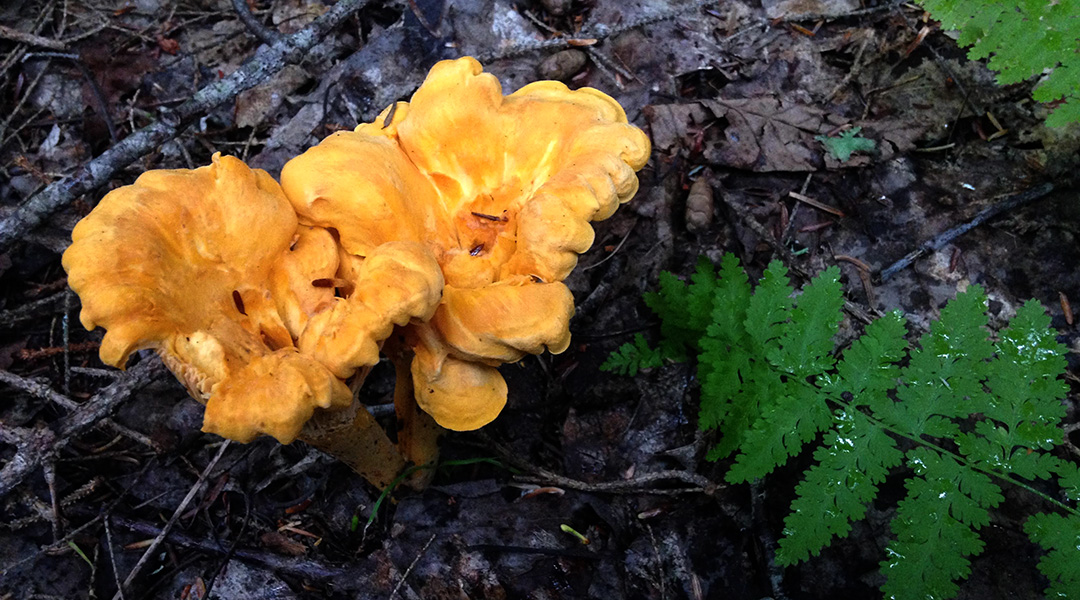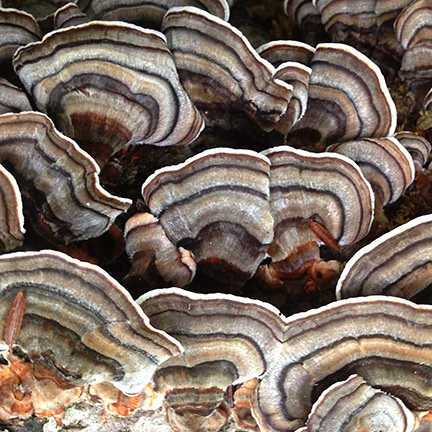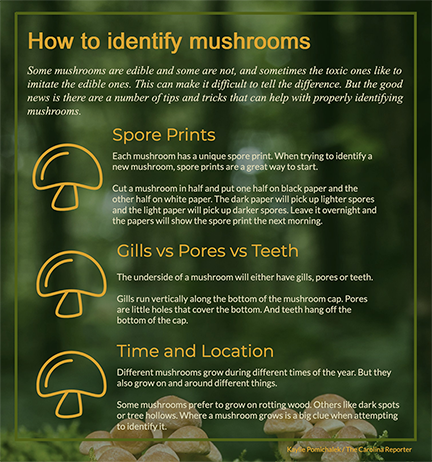Edible chanterelle mushrooms like to grow on the ground in wooded areas. (Photos courtesy of Matthew Kip)
Ashlie Khanted went down “a mushroom rabbithole” back in 2020. She spent multiple hours a day watching videos and reading anything she could about mushrooms and foraging.
She also joined the South Carolina Mushroom Group on Facebook.
“There were probably 15 people in the group,” she said. Now, two years later, the group has almost 4,000 members.
The mushroom foraging community simply has exploded.
Matthew Kip, the owner of Full Belly Foraging, said Columbia isn’t the best place for foraging. But that doesn’t mean there aren’t mushrooms here to be found.
“Year round, I do some pretty good foraging along the river walks — so the Saluda Riverwalk, the Cayce Riverwalk,” he said.
Two mushrooms that can be found along the river walks are chanterelles and oysters. Those mushrooms are great for beginners since they are easy to identify, so easier to find, Kip said.
The mountains are the best place for foraging for mushrooms since there’s a lot of biodiversity there. But it’s still possible to find some without going in the woods, Khanted said.
“If you look for a big ol’ oak tree with a hole in it, sometimes … there will be (a lion’s mane) in there growing,” she said. “So that’s the urban foraging part of it too. … Sometimes, you can just find stuff walking on the sidewalk.”
HOW TO FORAGE FOR MUSHROOMS
Olga Katie is the owner of Mushroom Mountain in Easley, South Carolina.
She suggests joining a foraging group, which can be found online or through companies such as Mushroom Mountain.
“(Foraging) is something that you just have to go out and do,” Khanted said. “When you first start to go out, you’re not going to know where to look. You’re not going to trust yourself when you find something. You’re going to have just so many questions. And that’s when those groups come in handy.”
Members of the South Carolina Mushroom Group send pictures of mushrooms they have found to fellow members when they need help identifying them.
A local guide or mushroom identification app are also helpful tools.
It’s important to have an idea of what to look for when foraging because some mushrooms have look-alikes that could be dangerous, seasoned foragers advise.
For example, jack o’lantern mushrooms look a lot like chanterelles. But you can’t eat jack o’lanterns without getting an upset stomach, Kip said.
“We definitely have some toxic mushrooms.” he said. “People who are just getting into this — approach it with caution.”
Touching a mushroom is not harmful, and eating a toxic mushroom isn’t necessarily deadly. It’s just not a very pleasant time, Khanted said.
“You can touch any mushroom,” she said. “You can pick up any mushroom. You can smell any mushroom.”
Khanted recommends keeping any unknown mushrooms separate when foraging though, to prevent cross contamination between edible mushrooms and potentially toxic ones.
So what are some ways to identify mushrooms?
One of the best ways is by taking a spore print. Cut a mushroom in half and put one half on black paper and the other half on white paper, Kip said. Then, leave them overnight. The black paper will show lighter spores and the white paper will show darker spores.
It’s also important to look at the characteristics of each mushroom according to expert foragers – Does the mushroom have pores, gills or teeth? What is it growing on or around? What time of year is it?
Jack o’lantern mushrooms grow in the winter and chanterelles grow in the summer, Kip said. So if a forager thinks they’ve found a chanterelle in December it’s probably the toxic twin.
Foraging and identifying is only the first step in the mushrooming process though. You still have to take them home and clean them before you can do anything with them.
WHAT TO DO WITH MUSHROOMS
A lot of mushrooms you forage can be added to foods or cooked by themselves.
“Anytime I find edible mushrooms, I definitely take them home and cook them up right away,” Kip said.
Mushrooms have been eaten and used for its medicinal properties for thousands of years. Studies have shown mushrooms have antioxidant, anti-inflammatory and anticancer effects, according to the Harvard School of Public Health.
Mushrooms can be used to make teas and added to pasta or eggs or soups. And Kip enjoys chanterelles and oyster mushrooms so much he doesn’t really add anything to them. He might add some butter and salt, but he said it’s not necessary.
Mushrooms also make a pretty good substitute for meat.
“For people who are vegetarian and vegan, (mushrooms) give you just so many options in terms of texture, flavor and vitamins,” Khanted said.
Chicken of the woods, which grows in late fall and early winter, is a great example. Khanted uses it for tacos, chicken tikka masala and sandwiches. Kip said it makes a pretty convincing chicken quesadilla, too.
Chicken of the woods “is amazing in that it tastes, and even pulls apart, like chicken,” he said.
Foragers also have the option of selling mushrooms to local restaurants and markets. But they need to be certified to do that.
The Wild Mushroom Food Safety Certification is a five-year certification that allows for the sale of wild mushrooms.
Mushroom Mountain is one place where foragers can get certified. The course provides information on all kinds of edible mushrooms and how to identify them.
“It’s a very involved class,” Katic said. “After (people) complete our class, they are absolutely ready.”
The main thing about selling mushrooms is to stick with the well-known ones, Kip said.
“Selling really obscure mushrooms that no one’s sure of and people haven’t seen — understandably, people get a little wary.”
It’s been a while since Kip has sold any mushrooms. But in the past he has sold to different restaurants and to Rosewood Market — particularly oyster mushrooms.
Rosewood Market produce manager Kevin Brumfield said how much the store pays depends on the kind of mushrooms they are. But he also has to consider what goes into foraging.
The selling part of foraging is fun because it’s possible to earn $50 after foraging for five minutes, Kip said.
But it’s also possible that those end up being the only mushrooms he finds that week. It just depends on the week.
For Khanted, foraging is about having fun.
“Whenever you find something, you just get so excited,” Khanted said. “And I never had the kind of excitement before in my life, about anything. … It makes your whole week whenever you find something for the first time.”





